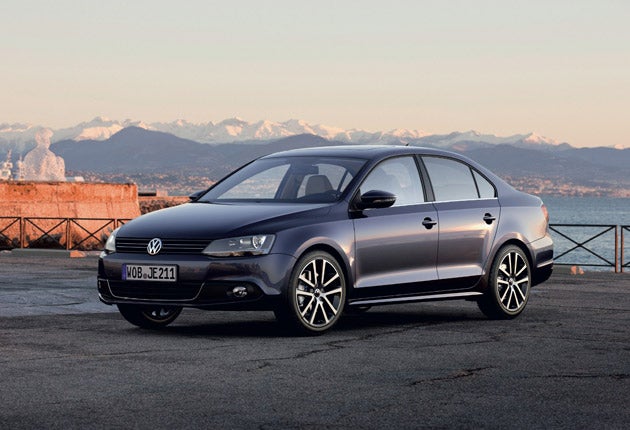Volkswagen Jetta 2.0 TDI
VW's new small saloon is just a cynical attempt to make as much profit as possible. But it won't work in Europe

Your support helps us to tell the story
From reproductive rights to climate change to Big Tech, The Independent is on the ground when the story is developing. Whether it's investigating the financials of Elon Musk's pro-Trump PAC or producing our latest documentary, 'The A Word', which shines a light on the American women fighting for reproductive rights, we know how important it is to parse out the facts from the messaging.
At such a critical moment in US history, we need reporters on the ground. Your donation allows us to keep sending journalists to speak to both sides of the story.
The Independent is trusted by Americans across the entire political spectrum. And unlike many other quality news outlets, we choose not to lock Americans out of our reporting and analysis with paywalls. We believe quality journalism should be available to everyone, paid for by those who can afford it.
Your support makes all the difference.Profits, doom. Hold those thoughts. Now, having set a cheery frame of mind, let me tell you about the new Volkswagen Jetta. "Ah, yes," you might be thinking, "that's the Golf with a boot. A Golf saloon."
But I must ask you to set aside all you think you know about past Golfs-with-boots. Which might be that Golfs Mark One and Two had Jetta versions, Mark Three was instead called Vento and was spectacularly awkward-looking, and Mark Four was called Bora. The Bora was a handsome little saloon, actually, and a desirable object, especially when powered by a weird but effective V5 engine. Mark Five? Jetta again, as indeed all the previous ones were outside Europe. Now we're at Mark Six, but things have changed.
The US has always been the strongest market for Jettas. In Europe, by contrast, the small saloon has practically vanished as a marketable object except in far-flung eastern parts. Not even Spain, Portugal and Ireland, former strongholds of the breed, seem interested any more.
It would be wise, then, not to invest too much money in the hope of the new Jetta's European sales success. Sales here would be icing on a lucrative cake formed from building the Jetta in labour-cheap Mexico and selling it in the US where buyers will clamour for it. Even if you were not aware of Volkswagen's cunning plan, a brief look at the Jetta will give you the right clues.
First, the big picture and the chief divergence from past Jettas. The wheelbase is now 70mm longer than the Golf's, to the great benefit of rear-seat space and visual proportions. The rear overhang no longer overwhelms the profile, and the Jetta looks quite a handsome car in its own right. It's as big as a Passat used to be.
No exterior panels are shared with the Golf. In most markets the rear suspension isn't shared, either, the sophisticated five-link system being ditched for a simple torsion-beam axle because buyers might not notice, nor even care. For us, though, the Jetta has proper Golf suspension, electric power steering and the latest in Golf-range engines. So it's a proper premium-feeling small saloon oozing Volkswagen quality, yes?
No, despite selling from £17,000 – broadly Golf-matching prices. A Golf has an interesting dashboard with neat detailing and dial glasses angled towards each other, and its door trims are properly padded as a quality car's should be. This Jetta has its own dashboard, a dull edifice clearly designed by the work-experience student, and the doors are hard plastic right up to the windows, like a cheap supermini's.
More cost-cutting: today's VWs use their large boot badge as a combined release and handle. Push the top half and it tilts. This delightful piece of cleverness is denied to the Jetta. True, you can have leather seats and an array of optional multimedia, and some of the engines have BlueMotion stop-start and energy-recovery systems, but that's just feel-good bling applied to a car conceived to be as cheap to make as Volkswagen thinks it can get away with.
And to drive? It's like a slightly more lugubrious Golf, oddly enough, so it's competent, comfortable and quiet, with enough verve in its movements to keep a driver interested. The UK engine range includes two 1.4-litre petrol engines (122bhp with turbocharger, 160bhp with turbo- and supercharger), and two diesels. It was the diesels that I drove; the 105bhp 1.6 is gruff, not very lively but ultra-frugal with its 109g/km CO2 output, while the 140bhp 2.0 is smoother and punchier. It was matched in the test car to a DSG automatic gearbox, unfortunately lacking paddleshift controls. A hybrid version will follow.
The new Jetta is not a bad car. But, in the European context, it is a cynically-conceived, opportunist one whose place in the market is hard to gauge. Maybe there's a niche, but the Jetta seems to be a social misfit in Volkswagen's European range. Doubtless its profit margin is high, but over here I prophesy doom. Which is where we came in.
The Rivals
Chevrolet Cruze 2.0 VCDi LT: £17,325. 150bhp, 149g/km.
Korean-built Cruze is well equipped but crude in some detailing. Fidgety ride, anaesthetised steering.
Mitsubishi Lancer 2.0 DI-D GS3: £18,589. 140bhp, 169g/km.
Looks quite like the mad, bad, Evo but uses old-tech VW diesel. Plasticky interior, grumbly engine, poor CO2 figures.
Volvo S40 2.0 D3 ES: £21,670. 150bhp, 134g/km.
Originally meant to be a BMW 3-series rival, but bigger S60 now usurps that role. Likeable, handsome, good to drive, expensive.
Join our commenting forum
Join thought-provoking conversations, follow other Independent readers and see their replies
Comments